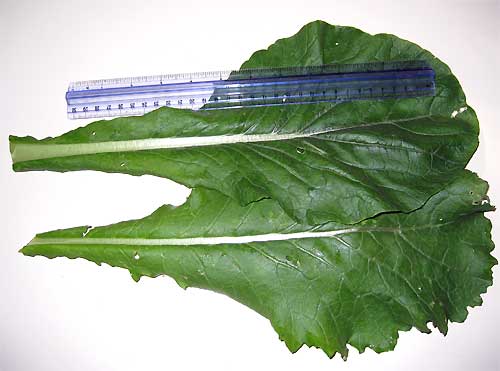 Back in the summer of 2008 when I was first ordering plants for our winter garden, I came across an item called "tyfon" or "Holland greens." It was in the section of the Territorial Seed catalog devoted to cover crops, and indeed when the seed packet arrived it said "EDIBLE GREEN MANURE." How appetizing! But in farming lingo, a "green manure" is just a cover crop that improves the soil... multiple sources said that tyfon could be eaten by people as well as animals, so I ordered it, along with several other crops that Territorial promised were winter-hardy.
Back in the summer of 2008 when I was first ordering plants for our winter garden, I came across an item called "tyfon" or "Holland greens." It was in the section of the Territorial Seed catalog devoted to cover crops, and indeed when the seed packet arrived it said "EDIBLE GREEN MANURE." How appetizing! But in farming lingo, a "green manure" is just a cover crop that improves the soil... multiple sources said that tyfon could be eaten by people as well as animals, so I ordered it, along with several other crops that Territorial promised were winter-hardy.
Guess what? None of the other crops were anywhere near as winter-hardy as the tyfon. It was the last plant producing leaves in the fall and the first to come up in the spring. I planted it again for the second winter, which turned out to be far more brutal than the first, and after the greenhouse collapsed in our Christmas Day snowstorm, the only two plants to survive the winter were tyfon and dandelion. What's more, Jessie and I found the greens to be palatable and versatile, and much to our surprise it's also been our most profitable and dependable crop at the farmer's market! So here are some of tyfon's great qualities:
 It keeps producing all season long. Plant it in the spring or fall -- you'll have greens all year, long after other varieties of greens have stopped producing, so if you sell them at market for a dollar a bag, a $4 packet of seeds can easily pay for itself more than 10 times over. When the plant does finally get around to bolting, the leaves actually get milder, more succulent, and less hairy. There's also a turnip-like root (photo at right), if you're into that sort of thing.
It keeps producing all season long. Plant it in the spring or fall -- you'll have greens all year, long after other varieties of greens have stopped producing, so if you sell them at market for a dollar a bag, a $4 packet of seeds can easily pay for itself more than 10 times over. When the plant does finally get around to bolting, the leaves actually get milder, more succulent, and less hairy. There's also a turnip-like root (photo at right), if you're into that sort of thing.- It likes heavy clay soil. Most of the other winter crops I planted didn't even germinate in our soil. Kale, mâche... the winter-garden all-stars wimped out, but tyfon was happy.
- It tolerates crowding. Radishes germinate well in our soil, but they have to be spaced apart or they just get leggy and useless. Tyfon is happy to grow shoulder-to-shoulder with its peers.
- It's disease resistant. Don't get me wrong, bugs eat it. But while the individual leaves get holes, the plant itself stays healthy. I have yet to see a sick tyfon plant.
- It's reasonably palatable and nutritious. Nobody's going to rave about the wonderful flavor of tyfon by itself. The leaves are so much milder than turnip greens, they're basically like cooked spinach. But as such they absorb flavors well, so you can cook them in soy sauce or ramen or with bacon or whatever flavor you like, and they come out tasting great. They make a good substitute for spinach in lasagna and other recipes -- Jessie made a chicken-with-greens dish that earned raves from everyone at a family potluck, and nobody guessed it wasn't spinach. I don't recommend eating tyfon greens raw, since they are hairy.
- It improves the soil -- theoretically. It's not a legume, so it doesn't add nitrogen. If you pull it up rather than tilling it in at the end of the season, the amount of organic matter it adds will be limited to the side roots, like any other crop. So I'm not counting on it to improve the soil, personally.
I wanted to share about this crop because nobody knows about it, and it has really saved our garden from mediocrity. Give tyfon a try!
Learn more about tyfon: http://www.wisegeek.com/what-are-holland-greens.htm
Unfortunately I no longer know of any sources for tyfon seed. Sorry to get your hopes up! Try something similar!
- Log in to post comments
